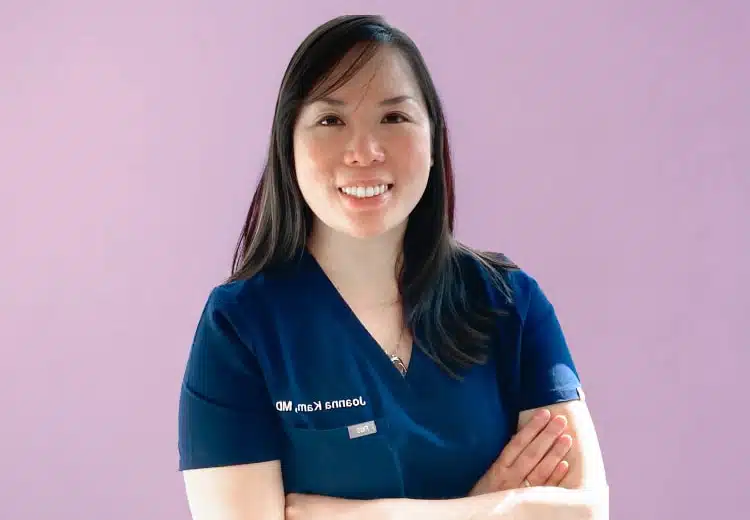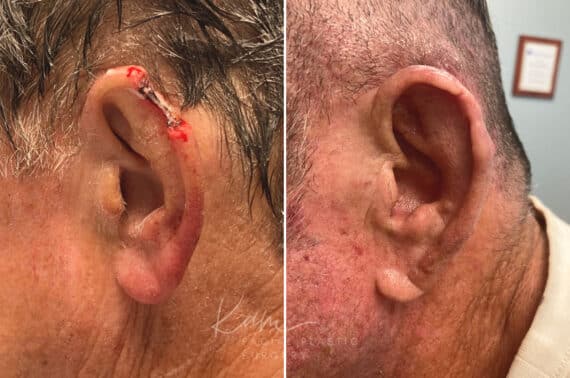
Benefits of Skin Cancer Reconstruction
Skin cancer, a prevalent health concern, demands effective treatment and aesthetic restoration. Dr. Joana Kam, with extensive experience, offers transformative skin cancer reconstruction. Patients regain a natural appearance, with functionality in affected areas meticulously preserved (neck, eyelids, lips, nose, ears, chin, and ears). Dr. Kam’s advanced techniques blend medical excellence with cosmetic finesse, promising a journey back to healthy skin.
Skin cancer reconstruction benefits include:
- Reduced scarring
- Restore symmetry
- Restore functionality to areas affected by skin cancer
- Same day results
Dr. Kam works with a dermatologist or Mohs surgeon, who removes the skin cancer before Dr. Kam performs the reconstruction. She uses advanced techniques to restore the form and function of the affected area while minimizing any disfigurement or scarring.
What is Skin Cancer Reconstruction?
Approximately 5 million people are treated for common types of skin cancer such as squamous cell carcinoma, basal cell carcinoma, or melanoma. Skin cancer is removed using cryotherapy, laser surgery, excision, or Mohs micrographic surgery (also known as Mohs). The removal typically leaves defects or scars. While it is critical to remove cancer, it is also essential for the patient to have access to the best reconstructive surgical options.
Mohs technology is especially effective for removing skin cancer in critical areas like the eyelids, face, ears, and nose. Mohs removes and examines thin layers of tissue under a microscope to ensure that the margins around the area are clear of cancer. During the surgical procedure, tiny frozen layers of skin are scanned to check for cancer cells, reducing the incision size and ensuring cancerous cells’ removal.
This type of plastic surgery restores defects caused by skin cancer removal, especially on aesthetically sensitive areas like the face, nose, and ears. After skin cancer removal, Dr. Kam performs reconstructive surgery. She addresses minor or extreme disfigurement on delicate areas of the face, head, and neck and restores the area as closely as possible to its original form and function. Dr. Kam specializes in intricate restoration and provides outstanding results. Ask for before and after photos at a skin cancer restoration consultation.


Skin Cancer Reconstruction Consultation
During the consultation, Dr. Kam examines the patient and discusses options for skin restoration. As a reconstructive surgeon, she focuses on revising the skin after removing skin cancer, either using excision, laser surgery, cryotherapy (freezing), or Mohs surgery. Even if the surgical excision was performed months or years ago, she can reconstruct the scarred region. Dr. Kam creates a surgical plan based on the area of the excision, the size, and the surrounding skin.
The plastic surgeon explained the best treatment option to the patient during the consultation. She also discusses the expected outcome, risks, benefits, and aftercare. Her ultimate goal is for the patient to return to daily life feeling confident with a restored normal appearance.

Skin Cancer Reconstruction Preparation
Patients receive detailed instructions during their skin cancer reconstruction consultation with Dr. Kam. Typically:
- Stop smoking at least 4 weeks before the surgery because it hinders the healing process.
- Advise the doctor of all medications, and follow instructions for pausing medications
- Report medical information, including devices like a pacemaker or stent.
- Avoid medications, vitamins, and herbal supplements that can cause excessive bleeding, including ibuprofen, aspirin, garlic, ginseng, and ginkgo.
- Avoid sunburn and sun exposure before the surgery.
- Avoid alcohol for 24 hours before the surgery.
- Ask a loved one for a ride to and from the surgery.
Suitable Candidates for Skin Cancer Reconstruction
Reconstruction surgery is a vital step in the journey toward healing and normalcy. Ideal candidates for this procedure are those who have undergone skin cancer removal and are seeking to restore their appearance and functionality. The process is tailored to individual needs, focusing on ensuring the natural look and feel of the skin. Here are some key characteristics:
- Candidates must have realistic expectations about the procedure’s outcomes.
- Those experiencing functional issues due to skin cancer surgery may benefit greatly.
- Emotional readiness for the reconstruction process is important for patient well-being.
- Individuals seeking aesthetic improvement post-cancer removal are ideal candidates.
Patient Reviews
The Skin Cancer Reconstruction Procedure
A specialized dermatologist treats basal cell carcinoma or squamous cell carcinoma by removing the skin cancer while sparing as much of the surrounding healthy tissue as possible. Carefully removing the cancer while limiting damage to the surrounding tissue is essential in sensitive facial areas, including lips, eyelids, nose, and ears. Dr. Kam uses reconstructive techniques to close complex skin cancer deficits after the dermatologist removes the lesion.
Anesthesia
Local anesthetic (numbing medicine) can be used alone or in combination with an anxiolytic to help the patient relax. The surgery can be performed in the office or an operating room.
Removal of a cancerous lesion
Depending on the nature of the skin cancer, Dr. Kam may remove the cancer or refer the patient to a specialized dermatologist, for cancer removal. After the removal of the cancer, Dr. Kam reconstructs the area.
Reconstruction procedure
If the facial skin cancer is extensive, its removal can cause disfigurement. Dr. Kam will reconstruct the area using a procedure known as adjacent tissue rearrangement. She repositions the healthy adjacent tissue to cover the wound, and the sutures are positioned along natural creases of the face, when possible, to reduce scarring.
Other options include using tissue from another area to create a skin grafting, using a substitute, or a tissue expander. Or a flap procedure, where a piece of tissue with its blood supply is moved from one area to another.
Reconstructive surgery and wound healing is a complicated process, and it may take more than one procedure, along with minor touch-ups, to optimize the final result. Dr. Kam explains the planned procedures during the consultation.

get the face of your dreams with dr. kam
Skin Cancer Reconstruction Recovery
Dr. Kam provides each patient with recovery instructions during the consultation. Follow her instructions to ensure the best possible results. Patients can call the office at any time to ask for assistance.

Patients should avoid sun exposure right after surgery because it can cause irregular pigmentation and raised, red, or dark scarring. Sunlight can also increase the risk of cancer developing in another area. Dr. Kam will examine the area within one week and provide additional instructions for resuming normal activities.
The incision site may be sore, and drain small amounts of fluid immediately after the surgery. Follow all wound care instructions. Limit activity and keep the incisions and wounds clean and protected.
The wound will heal during the first several weeks, and the scar will fade. Patients are encouraged to follow the scar care instructions for the first year to help the lines fade. In some cases, Dr. Kam may recommend additional procedures to achieve the best results.
Why Choose Dr. Kam for Your Skin Cancer Reconstruction
Double Board-Certified Facial Plastic Surgeon
- Joanna Kam, MD is a Facial Plastic Surgeon certified in Otolaryngology by the American Board of Otolaryngology-Head and Neck Surgery.
- She completed a residency in Otolaryngology–Head and Neck Surgery at Henry Ford Health System in Detroit, MI.
- Dr. Kam was one of a handful of students in her medical school class nominated to the prestigious Alpha Omega Alpha Honor Medical Society.


Skin Cancer Reconstruction Cost
The financial aspect of skin cancer reconstruction is an important consideration for many patients. The cost of this procedure can vary significantly, largely depending on the extent and complexity of the wound that needs to be addressed. In many cases, medical insurance will cover the costs associated with this essential treatment, alleviating financial concerns for patients. However, in instances where insurance coverage is not available or is declined, Dr. Joana Kam provides a detailed, customized reconstruction plan, including a transparent discussion about the associated costs. For further assistance and to ease the process, Dr. Kam’s friendly office staff are always on hand to help patients navigate through the financial aspects and provide support in making informed decisions about their treatment.
Risk and Complications After Skin Cancer Reconstruction
Facial skin cancer reconstruction, while highly beneficial, carries certain risks and complications, as with any surgical procedure.
- Risk of infection at the surgical site.
- Possibility of visible scars post-reconstruction.
- Complications in the healing process.
- Anesthesia complications during surgery.
- Altered or reduced sensation in the treated area.
- Potential for temporary or permanent nerve damage.
Dr. Joana Kam reduces the likelihood of complications. She is skilled in advanced surgical techniques and provides meticulous patient care. Every measure is taken to minimize risks and promote a successful recovery.





